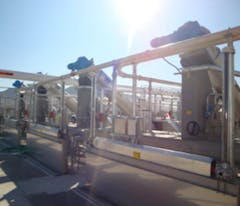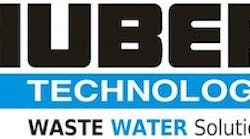The City of North Las Vegas’s field facility is a membrane bioreactor (MBR) plant that was brand new when Huber’s rotary fine screens were implemented as part of its water treatment and reclamation process. The facility is “smart,” using a level of technology at which few large plants operate and employing sophisticated security that even includes a laser perimeter. The technology enables constant processing, with 14 of its daily operational hours unmanned on site. Huber’s advanced fine screening technology plays a key role in this impressive and innovative technological lineup.
During the planning process, the City of North Las Vegas was advised by GE Water to include fine screens in its MBR plant design. The supplier of the bioreactor’s membrane recommended Huber’s center-feed drum screen to prevent wash around that can ruin the MBR.
North Las Vegas has installed some of the largest rotary fine screens operating in the United States. Each Huber Technology RPPS center feed drum screen measure 8.5 ft in diameter and is mounted in 10-ft-wide channels. The plant alternates the four such screens in processing an average flow of more than 8.5 mgd per screen; total plant flow of 34 mgd is possible. The center feed drum screens are critical to protecting the membrane bioreactor, enabling the plant to maintain extremely low turbidity.
“We consistently produce permeate that is an order of magnitude cleaner than what most cities have for drinking water,” said Dan Commons, water reclamation facility administrator. “Our permeate is consistently selected as the cleaner choice even when compared with bottled water in demonstrations for tour groups that visit our plant.”
Equipment
As noted above, North Las Vegas’s MBR plant is capable of producing high-quality permeate. This is possible because of the coordinated components that it operates. A coarse screen and two chambers at the head works separate many large solids from the plant’s flow before it reaches Huber’s Rotamat RPPS center feed drum screens.
Removing the large solids allows the Huber screens to work at their most productive capacity to prevent hair from reaching the reactor membrane. The fine screen protection is critical to the smooth operation of the bioreactor, the high quality of permeate produced and the protection of the membrane.
“We depend on the Huber fine screens as the final layer that can keep damaging hair strings from reaching the membrane strands,” said Layton Brown, the plant’s maintenance supervisor. “These screens are one of the most critical technologies in our plant.”
While some other MBR plants have implemented screens with 3-mm openings, North Las Vegas took its screen requirements down to 2-mm openings. By using the Huber Rotamat RPPS strategically within its process, the plant has a true layer of protection as the flow moves through a final chamber and to the membrane area.
Protection
If hair strings reach the bioreactor membrane, they can wrap around and cause buildup on individual membrane strands. This can result in obstruction of the flow around the membrane or breakage of the individual membrane strands. Obstruction or damage to a single strand would not be a significant issue. However, because buildup in this situation would be continuous, many strands would become damaged and create a combined impact that would jeopardize the water quality and require expensive repairs.
“Since there are 3,900 membrane strands in each cassette, it doesn’t seem that damaging or breaking one would matter,” said Commons. “However, hair buildup produces a snowball effect on the strands and can quickly escalate to very expensive and damaging levels. Cassettes are about $250,000 each to replace, and we would take a $15 million hit if we had to replace all of our membrane strands, so we’re very protective of them.”
Hair is a big deal within a water reclamation plant’s flow. While each strand is tiny, many can become tangled to create hair masses of monstrous proportions. Commons’s previous
plant experience gave him opportunity to witness a tangled hair mass measuring 20 to 30 ft in length and 3 ft in diameter moving within the flow. With that type of potential, it is clear to see why treatment strategies that employ proven fine screen technology are implemented and why Huber’s Rotamat RPPS is high-priority equipment at the North Las Vegas plant. Huber’s Rotamat RPPS provides insurance that such a monstrous hair mass would never reach their bioreactor membrane.
Stay clean
To Commons and Brown, Huber’s technology stands out because its design is simple, which makes it easy to maintain and operate. The self-cleaning of the screen is accomplished through simple physics: When the flow reaches a set differential level, the screen rotates to clean itself off. If this process does not occur within a set time parameter, the self-cleaning process is started automatically.
“The design uses the backwash to clean the screen out,” said Brown. “It runs on the differential of the water on the up and down sides of the screen. When the elevation is right, it flips to clean. We make a couple of precautionary checks each month and clean everything off with fire hoses. But we rarely find an issue. We occasionally find solids to remove, and sometimes they are worth keeping. We even have the first dollar bill that we found in the screen framed in our office.”
Huber’s Rotamat RPPS is completely fabricated of stainless steel, with the exception of the polyurethane drum seal that prevents captured screenings from escaping the screen. In addition, the covers provide a barrier that prevents corrosive gasses from permeating the flow.
“The screen is an absolute barrier between [corrosive] gasses and the flow because of the seals and gaskets,” said Brown. “This plant has been up and running for more than 2 1⁄2 years and we’ve not had to change them yet. That really speaks to durability because the gasses that come off the sewer will eat right through metal.”
Teaching them to fish
The proverb “Give a man a fish and you feed him for a day; teach a man to fish and you feed him for a lifetime” is applicable to Huber’s service team. The North Las Vegas plant’s design implemented some industry innovations.
Experience with these new technologies was not a given among the plant operations teams. Huber’s service and support teams provided comprehensive training that included tips on early recognition of issues and ways to reduce maintenance and repair costs. The North Las Vegas team was eager to learn from the Huber service team and became adept at good maintenance procedures. This is exactly what Huber intended, since the service team’s mantra is to share its knowledge so that clients can take good care of their equipment and perform preventative maintenance.
“Huber’s folks even gave us ‘what happens if you don’t’ scenarios that helped us to drive home the importance of maintenance to the entire team and to the plant,” said Brown. “The Huber component is vital to our plant, and we take great pains to do what they recommend between the visits provided by their maintenance contract.”



